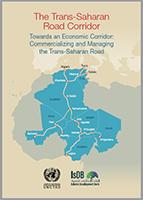
The Trans Saharan Road (TSR) corridor is one of the nine main Trans-African Highways (TAH) corridors being developed by the United Nations Economic Commission for Africa (UNECA), the African Union (AU), the Islamic Development Bank (IsDB) and the African Development Bank (AfDB) with the support of other regional and international organisations and development institutions (such as the Arab Bank for Economic Development in Africa - BADEA and UNCTAD).
The TSR corridor is also one of the oldest transnational road corridors in Africa and one of the most complete, having been proposed in 1962, with construction of sections in the Sahara starting in the 1970s. The TSR corridor links Algeria, Chad, Mali, Niger, Nigeria, and Tunisia (three port countries and three landlocked ones). The 4,500 km long North-South backbone (main road) of the corridor connects the ports of Algiers and Lagos through Algeria, Niger, and Nigeria. An additional 4,600 km of linked highways (feeders) to Tunisia, Mali, Niamey (in Niger) and Chad are considered an integral part of the TSR corridor. Some 80% of the TSR corridor is paved (asphalted) roads. The Tunisia branch connects to the ports of Tunis and Gabès.
The present study is part of the technical assistance project, funded by the IsDB and implemented by UNCTAD and which aims to promote the commercialization of the TSR corridor and its evolution towards an economic corridor and by establishing a relevant management mechanism.
Evolution from Transport Corridor to Economic Corridor
It is important to establish a regional transport corridor management mechanism that will ensure effective coordination and collaboration among TSR corridor stakeholders, including users and service providers.
The ultimate objective of the TA project is to promote trade, improve the reliability and efficiency of transport, minimize delays and transit times through improved policies and processes, and reduce transportation costs, all of which will support transforming the road network into an economic development corridor and lay the ground for the establishment of the conditions for future regional economic integration.
In line with the overall goals of the TA project and as one of the first steps, the present study includes particularly recommendations for the establishment of a cooperation framework among the TSR countries and an adequate regional trade and transport transit corridor management mechanism for the commercialization of the TSR.
The study’s suggestions for TSR corridor improvements and recommendations (hard and soft), including a corridor management scheme, are made mainly to transform the TSR from road corridor to transport corridor, to logistics corridor and then to an economic corridor, with the goal of regional economic integration.


